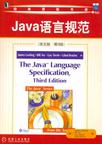JAVA语言规范(英文版,第3版)
出版时间:2006-4 出版社:机械工业 作者:戈斯林 页数:651
Tag标签:无
内容概要
本书由“java之父”Jame Gosling 以及另外三位顶级大师撰写而成,无论是对java语言的初学者还是专业程序员都具有极高的价值,是关于java程序设计语言最权威的技术参考书。 本书侧重于java技术细节和内幕,全面,准确,详尽地介绍了java语言及其语法,论述了java编译器所要检查的语法和java运行模式的各个方面,同时还描述了java语言最重要的新特征。
作者简介
作者:(美)戈斯林 等James Gosling 拥有卡内基-梅隆大学计算机科学博士学位。他是Java语言的创建者,Sun公司Developer Products组的高级成员和首席术官,同时还是计算机业最负盛名的程序员之一。1996年。他获得了《Software Development》杂志“最佳编程奖”。他曾开发过NeWS——Sun公司的网络扩展窗口系统,并且是卡内基-梅隆大学Andrwe项目的负责人之一。
书籍目录
PrefacePreface to the Second EditionPreface to the Third EditionIntroduction1.1 Example Programs1.2 Notation1.3 Relationship to Predefined Classes and Interfaces1.4 References2 Grammars2.1 Context-Free Grammars2.2 The Lexical Grammar2.3 The Syntactic Grammar2.4 Grammar Notation3 Lexical Structure3.1 Unicode3.2 Lexical Translations3.3 Unicode Escapes3.4 Line Terminators3.5 Input Elements and Tokens3.6 White Space3.7 Comments3.8 Identifiers3.9 Keywords3.10 Literals3.10.1 Integer Literals3.10.2 Floating-Point Literals3.10.3 Boolean Literals 3.10.4 Character Literals3.10.5 String Literals3.10.6 Escape Sequences for Character and String Literals3.10.7 The Null Literal3.11 Separators3.12 Operators4 Types, Values, and Variables4.1 The Kinds of Types and Values4.2 Primitive Types and Values4.2.1 Integral Types and Values4.2.2 Integer Operations4.2.3 Floating-Point Types, Formats, and Values4.2.4 Floating-Point Operations4.2.5 The boolean Type and boolean Values4.3 Reference Types and Values4.3.1 Objects4.3.2 The Class Object4.3.3 The Class String4.3.4 When Reference Types Are the Same4.4 Type Variables4.5 parameterized Types4.5.1 Type Arguments and Wildcards4.5.1.1 Type Argument Containment and Equivalence4.5.2 Members and Constructors of Parameterized Types4.6 Type Erasure4.7 Reifiable Types4.8 Raw Types4.9 Intersection Types4.10 Subtyping4.10.1 Subtyping among Primitive Types4.10.2 Subtyping among Class and Interface Types4.10.3 Subtyping among Array Types4.11 Where Types Are Used4.12 Variables4.12.1 Variables of Primitive Type4.12.2 Variables of Reference Type4.12.2.1 Heap Pollution4.12.3 Kinds of Variables4.12.4 final Variables4.12.5 Initial Values of Variables4.12.6 Types, Classes, and Interfaces5 Conversions and Promotions5.1 Kinds of Conversion5. l. 1 Identity Conversions5.1.2 Widening Primitive Conversion5.1.3 Narrowing Primitive Conversions5.1.4 Widening and Narrowing Primitive Conversions5.1.5 Widening Reference Conversions5.1.6 Narrowing Reference Conversions5.1.7 Boxing Conversion5.1.8 Unboxing Conversion5.1.9 Unchecked Conversion5.1.10 Capture Conversion5.1.11 String Conversions5.1.12 Forbidden Conversions5.1.13 Value Set Conversion5.2 Assignment Conversion5.3 Method Invocation Conversion5.4 String Conversion5.5 Casting Conversion5.6 Numeric Promotions5.6.1 Unary Numeric Promotion5.6.2 Binary Numeric Promotion6 Names6.1 Declarations6.2 Names and Identifiers6.3 Scope of a Declaration6.3.1 Shadowing Declarations6.3.2 Obscured Declarations6.4 Members and Inheritance6.4.1 The Members of Type Variables, Parameterized Types, Raw Types and Intersection Types6.4.2 The Members of a Package6.4.3 The Members of a Class Type6.4.4 The Members of an Interface Type6.4.5 The Members of an Array Type6.5 Determining the Meaning of a Name6.5.1 Syntactic Classification of a Name According to Context6.5.2 Reclassification of Contextually Ambiguous Names6.5.3 Meaning of Package Names6.5.3.1 Simple Package Names7 Packages8 Classes8.1.1 Class Modifiers8.1.1.1 abstract Classes8.1.1.2 final Classes8.1.1.3 stri ctfp Classes8.1.2 Generic Classes and Type Parameters8.1.3 Inner Classes and Enclosing Instances8.1.4 Superclasses and Subclasses8.1.5 Superinterfaces8.1.6 Class Body and Member Declarations8.2 Class Members8.2.1 Examples of Inheritance8.2.1.1 Example: Inheritance with Default Access8.2.1.2 Inheritance with public and protected8.2.1.3 Inheritance with private8.2.1.4 Accessing Members of Inaccessible Classes8.3 Field Declarations8.3.1 Field Modifiers8.3.1.1 static Fields8.3.1.2 fi nal Fields8.3.1.3 transient Fields8.3.1.4 vo] ati 1 e Fields8.3.2 Initialization of Fields8.3.2.1 Initializers for Class Variables8.3.2.2 Initializers for Instance Variables8.3.2.3 Restrictions on the use of Fields during Initialization8.3.3 Examples of Field Declarations8.3.3.1 Example: Hiding of Class Variables8.3.3.2 Example: Hiding of Instance Variables8.3.3.3 Example: Multiply Inherited Fields8.3.3.4 Example: Re-inheritance of Fields8.4 Method Declarations8.4.1 Formal Parameters8.4.2 Method Signature8.4.3 Method Modifiers8.4.3.1 abst tact Methods8.4.3.2 static Methods8.4.3.3 fina] Methods8.4.3.4 native Methods8.4.3.5 strictfp Methods8.4.3.6 synch roni zed Methods8.4.4 Generic Methods8.4.5 Method Return Type8.4.6 Method Throws8.4.7 Method Body8.4.8 Inheritance, Overriding, and Hiding8.4.8.1 Overriding (by Instance Methods)8.4.8.2 Hiding (by Class Methods)8.4.8.3 Requirements in Overriding and Hiding6.5.3.2 Qualified Package Names6.5.4 Meaning of PackageOrTypeNames6.5.4.1 Simple PackageOrTypeNames6.5.4.2 Qualified PackageOrTypeNames6.5.5 Meaning of Type Names6.5.5.1 Simple Type N. ames6.5.5.2 Qualified Type Names6.5.6 Meaning of Expression Names6.5.6.1 Simple Expression Names6.5.6.2 Qualified Expression Names6.5.7 Meaning of Method Names6.5.7.1 Simple Method Names6.5.7.2 Qualified Method Names6.6 Access Control 1386.6.1 Determining Accessibility6.6.2 Details on protected Access6.6.2.1 Access to a protected Member6.6.2.2 Qualified Access to a protected Constructor6.6.3 An Example of Access Control6.6.4 Example: Access to public and Non-public Classes6.6.5 Example: Default-Access Fields, Methods, and Constructors6.6.6 Example: public Fields, Methods, and Constructors6.6.7 Example: protected Fields, Methods, and Constructors6.6.8 Example: private Fields, Methods, and Constructors6.7 Fully Qualified Names and Canonical Names6.8 Naming Conventions6.8.1 Package Names6.8.2 Class and Interface Type Names6.8.3 Type Variable Names6.8.4 Method Names6.8.5 Field Names6.8.6 Constant Names6.8.7 Local Variable and Parameter Names7 Packages7.1 Package Members7.2 Host Support for Packages7.2.1 Storing Packages in a File System7.2.2 Storing Packages in a Database7.3 Compilation Units7.4 Package Declarations7.4.1 Named Packages :7.4.1.1 Package Annotations7.4.2 Unnamed Packages7.4.3 Observability of a Package7.4.4 Scope of a Package Declaranon7.5 Import Declarations7.5.1 Single-Type-Import Declaration7.5.2 Type-Import-on-Demand Declaration7.5.3 Single Static Import Declaration7.5.4 Static-Import-on-Demand Declaration7.5.5 Automatic Imports7.5.6 A Strange Example7.6 Top Level Type Declarations7.7 Unique Package Names8 Classes8.1 Class Declaration9 Interfaces10 Arrays11 Exceptions12 Execution13 Binary Compatibility14 Blocks and Statements15 Expressions16 Definite Assignment17 Threads and Locks 18 Syntax19 Index20 Credits21 Colophon
编辑推荐
本书由“java之父”Jame Gosling 以及另外三位顶级大师撰写而成,无论是对java语言的初学者还是专业程序员都具有极高的价值,是关于java程序设计语言最权威的技术参考书。 本书侧重于java技术细节和内幕,全面,准确,详尽地介绍了java语言及其语法,论述了java编译器所要检查的语法和java运行模式的各个方面,同时还描述了java语言最重要的新特征。
图书封面
图书标签Tags
无
评论、评分、阅读与下载
